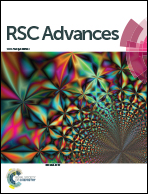Robust colorimetric detection based on the anti-aggregation of gold nanoparticles for bromide in rice samples†
Abstract
Inorganic bromide (Br−) is an important contaminant ion as it can originate from the overuse of illegal methyl bromide as a fumigant in stored rice samples. Herein, we developed a simple and highly sensitive colorimetric sensor for bromide ion detection in rice samples. The sensor is based on the anti-aggregation of gold nanoparticles (AuNPs) by Br− in the presence of Cr3+, which made the method more selective than other typical aggregations of nanoparticles. The AuNPs underwent an aggregation process as a result of the coordination of Cr3+ and the carboxylate group of a citrate ion stabilized the AuNPs, resulting in a red-to-blue color change. When Br− was pre-mixed with the AuNPs and Cr3+ was added, the solution color changed from blue to red with an increase in the Br− concentration. The anti-aggregation process can be detected with the naked eye and monitored using UV-vis spectrophotometry. The linear calibration curve ranged between 0.31 and 3.75 μM Br− with a low LOD and LOQ of 0.04 and 0.13 μM. The recovery was excellent, ranging from 79.9–92.2% with an RSD of less than 4.0%. The good inter-day and intra-day precisions were 2.9–6.4% and 3.1–7.1%, respectively. The developed sensor has proved to provide a robust method for Br− detection in rice samples.



 Please wait while we load your content...
Please wait while we load your content...